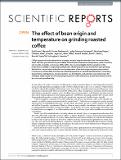| dc.contributor.author | Uman, Erol | |
| dc.contributor.author | Colonna-Dashwood, Maxwell | |
| dc.contributor.author | Colonna-Dashwood, Lesley | |
| dc.contributor.author | Perger, Matthew | |
| dc.contributor.author | Klatt, Christian | |
| dc.contributor.author | Leighton, Stephen | |
| dc.contributor.author | Miller, Brian | |
| dc.contributor.author | Butler, Keith T. | |
| dc.contributor.author | Melot, Brent C. | |
| dc.contributor.author | Speirs, Rory W. | |
| dc.contributor.author | Hendon, Christopher H | |
| dc.date.accessioned | 2017-04-06T19:32:25Z | |
| dc.date.available | 2017-04-06T19:32:25Z | |
| dc.date.issued | 2016-04 | |
| dc.date.submitted | 2015-12 | |
| dc.identifier.issn | 2045-2322 | |
| dc.identifier.uri | http://hdl.handle.net/1721.1/107913 | |
| dc.description.abstract | Coffee is prepared by the extraction of a complex array of organic molecules from the roasted bean, which has been ground into fine particulates. The extraction depends on temperature, water chemistry and also the accessible surface area of the coffee. Here we investigate whether variations in the production processes of single origin coffee beans affects the particle size distribution upon grinding. We find that the particle size distribution is independent of the bean origin and processing method. Furthermore, we elucidate the influence of bean temperature on particle size distribution, concluding that grinding cold results in a narrower particle size distribution, and reduced mean particle size. We anticipate these results will influence the production of coffee industrially, as well as contribute to how we store and use coffee daily. | en_US |
| dc.language.iso | en_US | |
| dc.publisher | Nature Publishing Group | en_US |
| dc.relation.isversionof | http://dx.doi.org/10.1038/srep24483 | en_US |
| dc.rights | Creative Commons Attribution | en_US |
| dc.rights.uri | http://creativecommons.org/licenses/by/4.0/ | en_US |
| dc.source | Nature Publishing Group | en_US |
| dc.title | The effect of bean origin and temperature on grinding roasted coffee | en_US |
| dc.type | Article | en_US |
| dc.identifier.citation | Uman, Erol et al. “The Effect of Bean Origin and Temperature on Grinding Roasted Coffee.” Scientific Reports 6 (2016): 24483. © 2017 Macmillan Publishers Limited | en_US |
| dc.contributor.department | Massachusetts Institute of Technology. Department of Chemistry | en_US |
| dc.contributor.mitauthor | Hendon, Christopher H | |
| dc.relation.journal | Scientific Reports | en_US |
| dc.eprint.version | Final published version | en_US |
| dc.type.uri | http://purl.org/eprint/type/JournalArticle | en_US |
| eprint.status | http://purl.org/eprint/status/PeerReviewed | en_US |
| dspace.orderedauthors | Uman, Erol; Colonna-Dashwood, Maxwell; Colonna-Dashwood, Lesley; Perger, Matthew; Klatt, Christian; Leighton, Stephen; Miller, Brian; Butler, Keith T.; Melot, Brent C.; Speirs, Rory W.; Hendon, Christopher H. | en_US |
| dspace.embargo.terms | N | en_US |
| mit.license | OPEN_ACCESS_POLICY | en_US |
| mit.metadata.status | Complete | |
